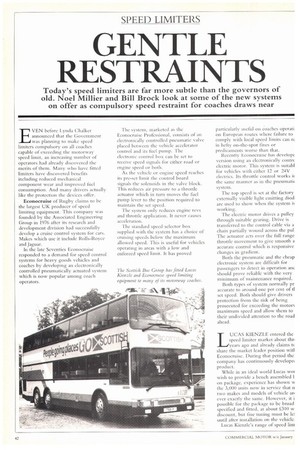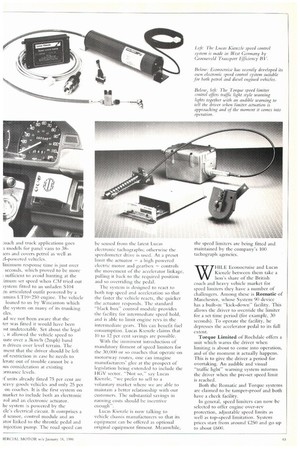GENTLE RESTRAINTS
Page 42

Page 43

If you've noticed an error in this article please click here to report it so we can fix it.
Today's speed limiters are far more subtle than the governors of old. Noel Millier and Bill Brock look at some of the new systems on offer as compulsory speed restraint for coaches draws near
EVEN before Lynda Chalker announced that the Government was planning to make speed limiters compulsory on all coaches capable of exceeding the motorway speed limit, an increasing number of operators had already discovered the merits of them. Many who have fitted limiters have discovered benefits including reduced mechanical component wear and improved fuel consumption. And many drivers actually like the protection the devices offer.
Econocruise of Rugby claims to be the largest UK producer of speed limiting equipment. This company was founded by the Associated Engineering Group in 1976 after its research and development division had successfully develop a cruise control system for cars. Makes which use it include Rolls-Royce and Jaguar.
In the late Seventies Econocruise responded to a demand for speed control systems for heavy goods vehicles and coaches by developing an electronically controlled pneumatically actuated system which is now popular among coach operators. The system, marketed as the Econocruise Professional, consists of an electronically controlled pneumatic valve placed between the vehicle accelerator control and its fuel pump. The electronic control box can be set to receive speed signals for either road or engine speed or both.
As the vehicle or engine speed reaches its pre-set limit the control board signals the solenoids in the valve block. This reduces air pressure to a throttle actuator which in turn moves the fuel pump lever to the position required to maintain the set speed.
The system only reduces engine revs and throttle application. It never causes acceleration.
The standard speed selector box supplied with the system has a choice of cruising speeds below the maximum allowed speed. This is useful for vehicles operating in areas with a low and enforced speed limit. It has proved particularly useful on coaches operati on European routes where failure to comply with local speed limits can rc in hefty on-the-spot tines or predicaments worse than that.
Recently Econocruise has developc version using an electronically contrc electric motor. This system is suitabl for vehicles with either 12 or 24V (..lectrics. Its throttle control works it the same manner as in the pneumati( system.
The top speed is set at the factory externally visible light emitting diod are used to show when the system is working.
The electric motor drives a pulley through suitable gearing. Drive is transferred to the control cable via a chain partially wound across the put The actuator acts over the full range throttle movement to give smooth a accurate control which is responsive changes in gradient.
Both the pneumatic and the cheap electronic system are difficult for passengers to detect in operation ant should prove reliable with the very minimum of maintenance required.
Both types of system normally pr accurate to around one per cent of tl set speed. Both should give drivers protection from the risk of being prosecuted for exceeding the motors maximum speed and allow them to their undivided attention to the road ahead.
UCAS KIENZLE entered the speed limiter market about thr, years ago and already claims tt share the market leader position witl Econocruise. During that period the company has continuously develope( product.
While in an ideal world Lucas woi wish to provide a bench assembled on package, experience has shown vt the 3,000 units now in service that n two makes and models of vehicle an ever exactly the same. However, it i possible for the package to be broad specified and fitted, at about £310 w discount, but fine tuning must be lei until after installation on the vehicle.
Lucas Kienzle's range of speed lim
:oach and truck applications goes a models for panel vans to 38iers and covers petrol as well as el-powered vehicles.
linimum response time is just over seconds, which proved to be more sufficient to avoid hunting at the imum set speed when CM tried out system fitted to an unladen S104 en articulated outfit powered by a [mins LT10-250 engine. the vehicle loaned to us by Wincanton which the system on many of its trunking cies.
ad we not been aware that the ter was fitted it would have been )st undetectable. Set about the legal it allowed the vehicle speed to uate over a 3km/h (2mph) band n driven over level terrain. The .ment that the driver should be left of restriction in case he needs to lerate out of trouble cannot be a nis consideration at existing ,)rmance levels.
units already fitted 75 per cent are wavy goods vehicles and only 25 per on coaches. It is the first system on market to include both an electronic :rol and an electronic actuator.
he system is powered by the ele's electrical circuit. It comprises a d sensor, control module and an ator linked to the throttle pedal and injection pump. The road speed can be sensed from the latest Lucas electronic tachographs; otherwise the speedometer drive is used. At a preset limit the actuator — a high powered electric motor and gearbox — controls the movement of the accelerator linkage, pulling it back to the required position and so overriding the pedal.
The system is designed to react to both top speed and acceleration so that the faster the vehicle reacts, the quicker the actuator responds. The standard "black box" control module provides the facility for intermediate speed hold, and is able to limit engine revs in the intermediate gears. This can benefit fuel consumption. Lucas Kienzle claims that 10 to 12 per cent savings are possible.
With the imminent introduction of mandatory fitment of speed limiters for the 30,000 or so coaches that operate on motorway routes, one can imagine manufacturers' glee at the prospect of legislation being extended to include the HGV sector. "Not so," say Lucas Kienzle, "we prefer to sell to a voluntary market where we are able to maintain a better relationship with our customers. The substantial savings in running costs should be incentive enough".
Lucas Kienzle is now talking to vehicle chassis manufacturers so that its equipment can be offered as optional original equipment fitment. Meanwhile,
WHILE Econocruise and Lucas Kienzle between them take a lion's share of the British coach and heavy vehicle market for speed limiters they have a number of challengers. Among these is Romatic of Manchester, whose System 90 device has a built-in "kick-down" facility, This allows the driver to override the limiter for a set time period (for example, 30 seconds). To operate the facility, he depresses the accelerator pedal to its full extent.
Torque Limited of Rochdale offers a unit which wanis the driver when limiting is about to come into operation, and of the moment it actually happens. This is to give the driver a period for overtaking. An audible and visual "traffic light" warning system informs the driver when the pre-set speed limit is reached.
Both the Romatic and Torque systems are claimed to be tamper-proof and both have a check facility.
In general, speed limiters can now be selected to offer engine over-rev protection, adjustable speed limits as well as top-speed limitation. System prices start from around £250 and go up to about £600.






















































